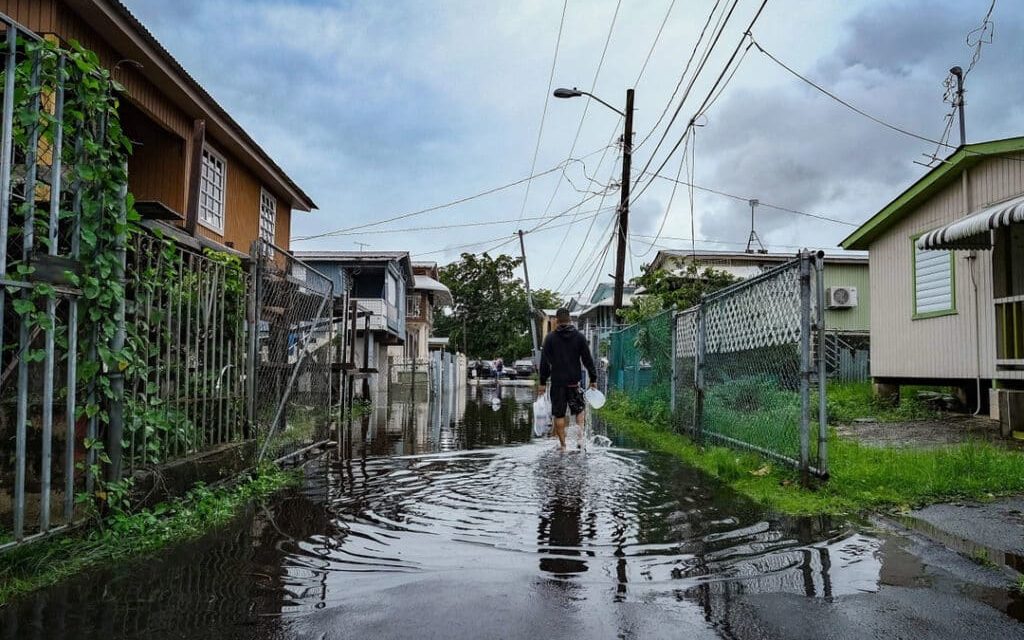Something absolutely can be done to repair the devastation caused by repeated hurricanes to the Puerto Rican community. There is a bill in Congress in Congress, HR 3339, to create a $5 trillion National Infrastructure Bank, which would be able to address all of Puerto Rico’s many emergency infrastructure needs, immediately.
It’s now been 5 years since Hurricane Maria struck the island, killed thousands of residents, and destroyed homes and infrastructure, with little progress in mitigation repairs. Now, Fiona—a category 1 storm delivering a year’s worth of rain in a day – has knocked out power, flooded homes, and shattered newly paved roads. Worse still, electricity service has not improved since a private company took over management of the grid in 2021. Frequent outages and high electricity fees were the norm, even before Fiona arrived.
No current government program appears up to the task of correcting Puerto Rico’s electricity and other infrastructure problems. The Bipartisan Infrastructure Law passed in Congress last year will provide the territory with only $2.3 billion for infrastructure repairs. That’s far below the American Society of Civil Engineers’ 2019 Report Card, which estimated a need of $13-23 billion over 10 years – to update infrastructure and support economic growth and competitiveness.
Very little of the $3 billion in FEMA assistance available since 2018 has actually been spent. Across the island, only 5 percent of the available FEMA funds for hazard mitigation have been obligated, and contracting begun. Only an aggressive investment program can save Puerto Rico.
HR3339, which is getting growing support in and out of Congress, would create a $5 trillion National Infrastructure Bank, or NIB, to finance projects that federal, state and local governments cannot afford. Puerto Rico would receive $48 billion over 10 years to cover all of the territory’s backlog in infrastructure improvements, including for roads (100% of which are in poor condition), bridges (13% are structurally deficient), drinking and wastewater systems ($3.3 billion needed over 10 years), levees and dams (that overflowed from Fiona’s destruction), affordable housing, public transportation, and more.
The massive investment would improve Puerto Rico’s economy—currently the lowest of any state or territory in the country—as well as create up to 240,000 family sustaining jobs, provide training, and improve state and local government finances. The National Infrastructure Bank would immediately extend financing of up to $3 billion for flood mitigation and stabilization of the electricity grid. Moreover, the NIB can deliver timely, sustained improvements with streamlined management and engineering expertise, compared to slower government programs.
The model for the NIB has been successfully done four times in our nation’s history thus far. The last one helped end the Great Depression and win World War II. The NIB would be capitalized with private investment and operate as a non-profit, deposit-taking bank. It requires no new federal taxes, spending or debt. Its lending operations would supercharge the American economy, reduce inflation and “lean” against the coming recession. It is ready to roll out today.
We are asking Congress to pass HR3339 now! Support for this legislation is growing in Congress and among grassroots organizations. Endorsements include the National Black Caucus of State Legislators, Council of State Governments East Region and National Latino Farmers and Ranchers Trade Association. Twenty-four state legislatures have introduced support resolutions to Congress, and eight have passed at least one house.
Let’s pass the bill, and build Puerto Rico into a model for infrastructure and development.
The following elected officials have signed in support of this Op-Ed:
Asm. Felix Ortiz, (f) Assistant Speaker, New York Assembly, Albany, NY
Rep. Christopher Rosario, District 128, Deputy Speaker, Connecticut House of Representatives, Bridgeport, Ct
Sen. Martin Dilan, (f) 18th District, New York State Senate, Brooklyn, NY
Sen. Victor Ramirez, (f) District 47, Maryland State Senate, Hyattsville, Md
Rep. Daisy Morales, District 48, Florida House of Representatives, Orlando, Fl
Tonio Burgos, CEO Tonio Burgos Associates, New York, NY
Charles A. Rodriguez, Chairman, Democratic Party of Puerto Rico, San Juan, PR
Janet Diaz, Lancaster City Council member, Lancaster, Pa
Del. Elizabeth Guzman, District 31, Virginia House of Delegates, Woodbridge, Va
Sen. Louis DiPalma, District 12, Rhode Island Senate, Middletown, RI
Sen. Bill Tallman, District 18, New Mexico Senate, Albuquerque, NM
Sen. Gerald Ortiz y Pino, District 12, New Mexico Senate, Albuquerque, NM
Sen. Dave Miramant, District 12 Maine Senate, Camden, Me
Rep. Eddie Day Pashinski, District 121, Pennsylvania House of Representatives, Wilkes-Barre, Pa
Rep. Joy Garratt, District 29, New Mexico House of Representatives, Albuquerque, NM
Rep. Pamela Powers Hannley, District 9, Arizona House of Representatives, Tucson, Az
Del. Sam Rasoul, District 11, Virginia House of Delegates, Roanoke, Va
Rep. Emily Kinkead, District 29, Pennsylvania House of Representatives, Pittsburgh, Pa
Rep. Patricia Boy, District 9, Indiana House of Representatives, Michigan City, In
Asm. Don Guardian, District 2, New Jersey Assembly, Atlantic City, NJ
Rep. Terri Cortvriend, District 72, Rhode Island House of Representatives, Portsmouth, RI
Rep. Yvonne Hinson, District 20, Florida House of Representatives, Gainesville, Fl
Maryjane Shimsky, District 12, Westchester County, NY, Board of Legislators, Dobbs Ferry, NY
Gayle McLaughlin, District 5, Richmond City Council member and former Mayor, Richmond, Ca
Fred R. Baca. New Mexico State LULAC Director, Silver City, NM
Ellen Brown, Chair, Public Banking Institute, Los Angeles, Ca
Stan Forczek, Principal Consultant, GI Consulting, Williamstown, NJ
Alphecca Muttardy, (f) Senior Economist, International Monetary Fund, Fairfax, Va









